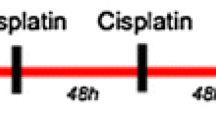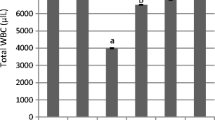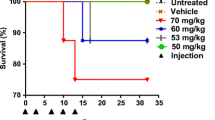Abstract
The protective effects of glutathione (GSH) administration on myelosuppression induced by 5-fluorouracil (5-FU) were investigated in female BALB/c mice. Animals were allocated to four groups (16 mice/group). GSH was given orally at a dose of 800 mg/kg to groups 3 and 4 for 21 consecutive days (day 0 to day 20). 5-FU was repeatedly administered at a dose of 40 mg/kg to groups 2 and 3 for 1 week (day 7 to day 13) by gavage. Group 3 served as a combined treatment group and group 1 as a non-treated control group. The total observation period was 3 weeks. Body weight was measured once a week. A decrease in body weight due to 5-FU treatment was observed in groups 2 and 3 on day 14. Although the body weight in group 2 had not increased by 1-week after cessation of 5-FU treatment, the value in group 3 markedly recovered. Hematology, total nucleated myelocyte count and histopathology of bone marrow were carried out on day 14 and day 21. In groups 2 and 3, these examinations showed thrombocytopenia, leukopenia, reticulocytopenia and myelosuppression on day 14. However, platelets and bone marrow were less affected in group 3 than in group 2. On day 21, the thrombocytopenia in groups 2 and 3 was resolved. The myelosuppression, leukopenia and reticulocytopenia resolved in group 3, but not in group 2. Although simple microcytic anemia occurred delayed on day 21, it was less severe in group 3 than in group 2. Therefore, GSH may have preventive effects against 5-FU-induced hematopoietic toxicity, and accelerate recovery after cessation of 5-FU treatment.



Similar content being viewed by others
References
Anderson ME (1998) Glutathione: an overview of biosynthesis and modulation. Chem Biol Interact 111:1-14
Boyd MR, Burka LT (1978) In vivo studies on the relationship between target organ alkylation and the pulmonary toxicity of a chemically reactive metabolite of 4-ipomeanol. J Pharmacol Exp Ther 207:687–697
Clarke E, Rice GC, Weeks RS, Jenkins N, Nelson R, Bianco JA, Singer JW (1996) Lisofylline inhibits transforming growth factor β release and enhances trilineage hematopoietic recovery after 5-fluorauracil treatment in mice. Cancer Res 56:105–112
Harrison SD Jr, Denine EP, Peckham JC (1978) Qualitative and quantitative toxicity of single and sequential sublethal doses of 5-fluorouracil in BDF mice. Cancer Treat Rep 62:533–545
Jollow DJ, Mitchell JR, Zampaglione N, Gillette JR (1974) Bromobenzene-induced liver hepatic necrosis. Protective role of glutathione and evidence for 3,4-bromobenzene oxide as the hepatotoxic metabolite. Pharmacology 11:151–169
Kosower NS, Kosower EM (1978) The glutathione status of cells. Int Rev Cytol 54:109–160
Macdonald JS (1999) Toxicity of 5-fluorouracil. Oncology 13 [Suppl 3]:33–34
Meister A (1991) Glutathione deficiency produced by inhibition of its synthesis, and its reversal; applications in research and therapy. Pharmacol Ther 51:155–194
Meister A (1994) Glutathione, ascorbate, and cellular protection. Cancer Res 54 [Suppl]:1969–1975
Meister A, Anderson ME (1983) Glutathione. Annu Rev Biochem 52:711–760
Mitchell JR, Jollow DJ, Potter WZ, Gillette JR, Brodie BB (1973) Acetaminophen-induced hepatic necrosis. IV. Protective role of glutathione. J Pharmacol Exp Ther 187:211–217
Mizutani T, Ito K, Nomura H, Nakanishi K (1990) Nephrotoxicity of thiabendazole in mice depleted of glutathione by treatment with dl-buthionine sulphoximine. Food Chem Toxicol 28:169–177
Mizutani T, Satoh K, Nomura H, Nakanishi K (1991) Hepatotoxicity of eugenol in mice depleted of glutathione by treatment with dl-buthionine sulphoximine. Res Commun Chem Pathol Pharmacol 71:219–230
Mizutani T, Nakahori Y, Yamamoto K (1994) p-Dichlorabenzene-induced hepatotoxicity in mice depleted of glutathione by treatment with buthionine sulfoximine. Toxicology 94:57–67
Naya M, Mataki Y, Takahira H, Deguchi T, Yasuda M (1990) Effects of phorone and/or buthionine sulfoximine on teratogenicity of 5-fluorouracil in mice. Teratology 41:275–280
Ninomiya Y, Ryu M, Matsuura N, Fujimoto K, Miwa M, Ishitsuka H (1988) Antitumor activity and the toxicity on the immune system and intestine of fluorinated pyrimidines, FUra, 5'-DFUR, tegafur and UFT. Jpn J Cancer Chemother 15:1747–1754
Novi AM (1981) Regression of aflatoxin B1-induced hepatocellular carcinomas by reduced glutathione. Science 212:541–542
Oh SI, Kim CI, Chun HJ, Park SC (1998) Chronic ethanol consumption affects glutathione status in rat liver. J Nutr 128:758–763
Parker WB, Cheng YC (1990) Metabolism and mechanism of action of 5-fluorouracil. Pharmacol Ther 48:381–395
Rotman G, Shiloh Y (1997) The ATM gene and protein: possible roles in genome surveillance, checkpoint controls and cellular defense against oxidative stress. Cancer Surv 29:285–304
Schuetz JD, Wallace HJ, Diasio RB (1984) 5-fluorouracil incorporation into DNA of CF-1 mouse bone marrow cells as a possible mechanism of toxicity. Cancer Res 44:1358–1363
Smith PF, Rush GF (1990) The role of glutathione in protection against chemically induced cell injury. In: Goldstein RS, Hewitt WR, Hook JB (eds) Toxic interaction. Academic Press, San Diego, pp99–136
Sugimura Y, Yamamoto K (1998) Effect of orally administered reduced- and oxidized-glutathione against acetaminophen-induced liver injury in rats. J Nutr Sci Vitaminol 44:613–624
Syng-Ai C, Basu Baul TS, Chatterjee A (2001) Inhibition of cell proliferation and antitumor activity of a novel organotin compound. J Environ Pathol Toxicol Oncol 20:333–342
Valeriote F, Santinelli G (1984) 5-Fluorouracil (FUra). Pharmacol Ther 24:107–132
Acknowledgements
The authors thank Dr. Masato Naya for his helpful advice, and Messers Hideki Muto, Masahiro Iio and Jitsuo Kashitani for their technical assistance.
Author information
Authors and Affiliations
Corresponding author
Rights and permissions
About this article
Cite this article
Kojima, S., Takaba, K., Kimoto, N. et al. Protective effects of glutathione on 5-fluorouracil-induced myelosuppression in mice. Arch Toxicol 77, 285–290 (2003). https://doi.org/10.1007/s00204-003-0448-9
Received:
Accepted:
Published:
Issue Date:
DOI: https://doi.org/10.1007/s00204-003-0448-9




